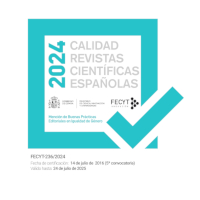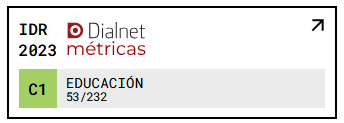Teacher’s thought and its influencein the implementation of the technologies of the information and communication inthe classroom: challenges and opportunities
DOI:
https://doi.org/10.18172/con.640Keywords:
Teaching thought, Information and Communications Technologies, teachers, attitudes, beliefsAbstract
The fundamental challenge of nowadays education is the implementation of information technologies and communication technologies (ICT shereafter) in the educational institutions in order to improve the managing and specially, the teaching-learning process quality. This article aims to analyze the reasons and barriers –primary and secondary ones– that exists in their implementation, focusing attention on the teacher thought of being considered a key factor. It starts on a general analysis of the structure and functioning of teacher thought focused on attitudes, beliefs and expectations, it assessing their influence on the integration of ICTs. The findings aim the need to give teachers a positive outlook towards the use of ICTs in a series of proposals that facilitate it implementation gradually.Downloads
References
Abrami, P. C. (2001). Understanding and promoting complex learning using technology. Educational Research and Evaluation, 7, 113-136.
Al-Senaidi, S., Lin, L. y Poirot, J. (2009). Barriers to adopting technology for teaching and learning in Oman. Computers & Education, 53, 575-590.
Angeli, C. y Valanides, N. (2009). Epistemological and methodological issues for the conceptualization, development, and assessment of ICT–TPCK: Advances in technological pedagogical content knowledge (TPCK). Computers & Education, 52, 154-168.
Arranz, P. (2002a). Representaciones mentales del profesorado respecto al Síndrome de Down: Implicaciones para un cambio en los modelos de formación. En S. Molina, Psicopedagogía del niño con síndrome de Down (pp. 299-354). Maracena, Granada: Arial.
Arranz, P. (2002b). Las representaciones mentales de los maestros en ejercicio y en formación respecto al síndrome de Down. Tesis doctoral inédita. Universidad de Zaragoza.
Bandura, A. (1987) Pensamiento y Acción. Barcelona: Martínez Roca.
Bandura, A. (1997). Self-efficacy: The exercise of control. New York, NY: Freeman.
Baylor, A. y Ritchie, D. (2002). What factors facilitate teacher skill, teacher morale, and perceived student learning in technology-using classrooms? Computers & Education 39(1), 395-414.
Bloch, S. y Maturana, H. (1996). Biología del Emocionar y Alba Emoting, Bailando Juntos. Santiago de Chile: Dolmen.
Cabero, J. (2001). Utilización de recursos y medios en los procesos de enseñanza-aprendizaje. En Actas de las IV Jornadas Nacionales de Desarrollo Curricular, Organizativo profesional. Jaén.
Cabero, J. (2008). TICs para la igualdad: la brecha digital en la discapacidad. Anales de la Universidad Metropolitana, 8(2), 15-43
Caracena, J. M. (2007). La identidad virtual y el trabajo colaborativo en red como bases para el cambio de paradigma en la formación permanente del profesorado. Revista DIM: Didáctica, Innovación y Multimedia, 10.
Ching, S. y Huang, Y.-F. (2008). A study of high school English teacher´s behavior, concerns and beliefs in integrating information technology into English instruction. Computers in human behavior, 24(3), 1085-1103.
Devos, G., Bouckenooghe, D., Engels, N., Hotton, G. y Aelterman, A. (2007). An assessment of well-being of principals in Flemish primary schools. Journal of Educational Administration, 45, 33-61.
Doomekamp, B. (1994). A implementaçao de Computadores no Ensino Secundario: O exemplo da Holanda. Revista da Escola Superior de Educaçao de Portoalegre, 16, 102-114.
Ertmer, P. (1999). Examining teachers’ beliefs about the role of technology in the elementary classroom. Journal of Research on Computing in Education, 32, 54-72.
Esteban, M. (2005). La Educación Permanente y las Nuevas Tecnologías ante las necesidades educativas actuales. Quaderns digitals. Monográfico educación comparada, 38, 1-9.
Gialamas, V. y Nikolopoulou, K. (2010). In-service and pre-service early childhood teachers’ views and intentions about ICT use in early childhood settings: A comparative study. Computers & Education (Articulo en prensa) .
Gilster, P. (1997). Digital Literacy. New York: Wiley Computer Publishing.
Gisbert, M. (2000). El profesor del siglo XXI: De transmisor de contenidos a guía del ciberespacio. En Cabero et al. (Coords.), Y continuamos avanzando. Las nuevas tecnologías para la mejora educativa (pp. 315-330). Sevilla: Kronos.
Gómez, J., Mur, J. y Sanz, J. (2010). Redes Sociales en educación: El camino hacia la escuela 2.0. Actas del II Congreso Galego de Investigación en Ciencias da Educación. Santiago de Compostela.
González, A. P. (1998). Más allá del curriculum: La educación ante el reto de las nuevas tecnologías de la información y la comunicación. Universitas Tarraconensis: Revista De Ciències De l'Educació, 22, 151-162.
Hawkridge, D. (1990). Who needs computers in school, and why? Computers and Education, 15, 1-6.
Hervás, C. y Martín, J. (1997). Evaluación de necesidades formativas, actitudes y creencias del profesorado de Educación Secundaria. Revista Electrónica Interuniversitaria de Formación del Profesorado, 1(0).
Hoban, G. (2002). Teacher learning for educational change. Buckingham: Open University Press.
Hughes, M. y Zachariah, S. (2001). An investigation into the relationship between effective administrative leadership styles and the use of technology. International Electronic Journal for Leadership in Learning, 5, 1-10.
Hulpia, H. y Valcke, M. (2004). The use of performance indicators in a school improvement policy: The theoretical and empirical context. Evaluation & Research in Education, 18, 102-120.
Iglesias, F., Veiga, E. y Gonzalez, M. (2000). Actitudes del profesorado de primaria hacia la informática: un estudio exploratorio. V Congreso Galego-Portugués de Psicopedagoxía Actas (Comunicacións e Posters), 6(4), 258-265.
Lajoie, S. P. (2003). Individual differences in spatial ability: developing technologies to increase strategy awareness and skills. Educational Psychologist, 38, 115-125.
Li-Ping, T. y Austin, M. J. (2009). Students’ perceptions of teaching technologies, application of technologies, and academic performance. Computers & Education, 53, 1241-1255.
Mac Beath, J. (1999). Schools Must Speak for Themselves: the Case for School Self-evaluation. London: Routledge.
Marqués, P. (2008). El impacto de las TIC en educación: funciones y limitaciones. Recuperado de: http://peremarques.pangea.org/siyedu.htm.
Mueller, J., Wood, E., Willoughby, T., Ross, C. y Specht, J. (2008). Identifying discriminating variables between teachers who fully integrate computers and teachers with limited integration. Computers & Education, 51, 1523-1537.
Murphy, C. A., Coover, D. y Owen, S. V. (1989). Development and validation of the computer self-efficacy scale. Educational and Pyschological Measurement, 49, 893-899.
Otto, T. L. y Albion, P. R. (2002). Understanding the role of school leaders in realizing the potential of ICTs in education. International conference of the association for the advancement of computing in education. Nashville.
Paraskeva, F., Bouta, H. y Papagiani, A. (2008). Individual characteristics and computer self-efficacy in secondary education teachers to integrate technology in educational practice. Computers & Education, 50(3), 1084-1091.
Perrenoud, P. (2002), Construir competencias desde la escuela, Dolmen ediciones, Santiago de Chile, Chile, p. 23
Prensky, M. (2001). Digital Natives, Digital Immigrants. On the Horizon 9(5), 1-6.
Richardson, V. (2003). Constructivist pedagogy. Teachers College Record, 105, 1623-1640.
Rosen, L. y Weil, M. (1995). Computer availability, computer experience and technophobia among public school teachers. Computers in Human Behavior, 11, 9-31.
Sefton-Green, J. (2006). Youth, technology, and media cultures. Review of Research in Education, 30, 279-306.
Snoeyink, R. y Ertmer, P. (2001). Thrust into technology: How veteran teachers respond. Journal of Educational Technology Systems, 30, 85-111.
Sutherland, R., Armstrong, V., Barnes, S., Brawn, R., Breeze, N. y Gall, M. (2004). Transforming teaching and learning: Embedding ICT into everyday classroom practices. Journal of Computer Assisted Learning, 20, 413-425.
Tang, P. S. y Ang, P. H. (2002). The diffusion of information technology in Singapore schools: A process framework. New Media & Society, 4, 457-478.
Tejedor, F. J., García-Valcárcel, A. y Prada, S. (2009). Medida de actitudes del profesorado universitario hacia la integración de las TIC. Comunicar, 17(33), 115-124.
Tezci, E. (2009). Teachers’ effect on ict use in education: the Turkey sample. Procedia Social and Behavioral Sciences, 1, 1285-1294.
Tondeur, J., van Keer, H., van Braak, J. y Valcke, M. (2008). ICT integration in the classroom: Challenging the potential of a school policy. Computers & Education, 51, 212-223.
Triggs, P. y John, P. (2004). From transaction to transformation: Information and communication technology, professional development and the formation of communities of practice. Journal of Computer Assisted Learning, 20, 416-439.
Veen, W. (1993). The role of beliefs in the use of information technology: Implications for teacher education, or teaching the right thing at the right time. Journal of Information Technology for Teacher Education, 2, 139-153.
Vega, M. T. y Isidro, A. I. (1997). Las creencias académico sociales del profesor y sus efectos. Revista Electrónica Interuniversitaria de Formación del Profesorado, 1(0).
Verdugo, M. A., Jenaro, C. y Arias, B. (1995). Actitudes sociales y profesionales hacia las personas con discapacidad: estrategias de evaluación e intervención”, en M. A. Verdugo y A. Aguado, Personas con discapacidad: perspectivas psicopedagógicas y rehabilitadoras. México, Siglo XXI, pp. 79-143.
Yang, S. C. y Huang, Y. (2008). A study of high school english teachers’ behavior, concerns and beliefs in integrating information technology into english instruction.Computers in Human Behavior, 24(3), 1085-1103.
Downloads
Published
How to Cite
Issue
Section
License
The authors retain copyright of articles and authorize Contextos Educativos. Revista de Educación the first publication. They are free to share and redistribute the article without obtaining permission from the publisher as long as they give appropriate credit to the editor and the journal.
Self-archiving is allowed too. In fact, it is recommendable to deposit a PDF version of the paper in academic and/or institutional repositories.












